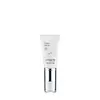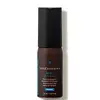What's inside
What's inside
 Key Ingredients
Key Ingredients

 Benefits
Benefits

 Concerns
Concerns

 Ingredients Side-by-side
Ingredients Side-by-side

Water
Skin ConditioningGlycerin
HumectantCoffea Robusta Seed Extract
Skin ConditioningSodium Hyaluronate
HumectantRhizobian Gum
Ascophyllum Nodosum Extract
Skin ConditioningChrysanthellum Indicum Extract
Skin ConditioningAsparagopsis Armata Extract
Skin ProtectingGlycosaminoglycans
EmollientSilica
AbrasiveSilica Silylate
EmollientHydroxyproline
Skin ConditioningTocopherol
AntioxidantMagnesium Ascorbyl Phosphate
AntioxidantAscorbyl Palmitate
AntioxidantDisodium Rutinyl Disulfate
AntioxidantSorbitol
HumectantLecithin
EmollientGlyceryl Stearate
EmollientButylene Glycol
HumectantGlyceryl Oleate
EmollientCarbomer
Emulsion StabilisingCaprylyl Glycol
Emollient1,2-Hexanediol
Skin ConditioningPropylene Glycol
HumectantAlcohol Denat.
AntimicrobialSodium Hydroxide
BufferingSorbic Acid
PreservativeTrisodium EDTA
Citric Acid
BufferingBenzyl Alcohol
PerfumingTriethanolamine
BufferingPotassium Sorbate
PreservativePhenoxyethanol
PreservativeChlorphenesin
AntimicrobialWater, Glycerin, Coffea Robusta Seed Extract, Sodium Hyaluronate, Rhizobian Gum, Ascophyllum Nodosum Extract, Chrysanthellum Indicum Extract, Asparagopsis Armata Extract, Glycosaminoglycans, Silica, Silica Silylate, Hydroxyproline, Tocopherol, Magnesium Ascorbyl Phosphate, Ascorbyl Palmitate, Disodium Rutinyl Disulfate, Sorbitol, Lecithin, Glyceryl Stearate, Butylene Glycol, Glyceryl Oleate, Carbomer, Caprylyl Glycol, 1,2-Hexanediol, Propylene Glycol, Alcohol Denat., Sodium Hydroxide, Sorbic Acid, Trisodium EDTA, Citric Acid, Benzyl Alcohol, Triethanolamine, Potassium Sorbate, Phenoxyethanol, Chlorphenesin
Water
Skin ConditioningDipropylene Glycol
HumectantButylene Glycol
HumectantUndecane
EmollientBis-Hydroxyethoxypropyl Dimethicone
EmollientAlcohol Denat.
AntimicrobialAscorbic Acid
AntioxidantDimethicone
EmollientCaprylic/Capric Triglyceride
MaskingTridecane
PerfumingPhloretin
AntioxidantLauryl PEG-9 Polydimethylsiloxyethyl Dimethicone
Skin ConditioningDimethicone/PEG-10/15 Crosspolymer
Dimethicone/Polyglycerin-3 Crosspolymer
CleansingFerulic Acid
AntimicrobialRuscus Aculeatus Root Extract
AstringentCaffeine
Skin ConditioningDisodium EDTA
Sodium Hydroxide
BufferingWater, Dipropylene Glycol, Butylene Glycol, Undecane, Bis-Hydroxyethoxypropyl Dimethicone, Alcohol Denat., Ascorbic Acid, Dimethicone, Caprylic/Capric Triglyceride, Tridecane, Phloretin, Lauryl PEG-9 Polydimethylsiloxyethyl Dimethicone, Dimethicone/PEG-10/15 Crosspolymer, Dimethicone/Polyglycerin-3 Crosspolymer, Ferulic Acid, Ruscus Aculeatus Root Extract, Caffeine, Disodium EDTA, Sodium Hydroxide
Alternatives
Ingredients Explained
These ingredients are found in both products.
Ingredients higher up in an ingredient list are typically present in a larger amount.
Alcohol Denat. is an alcohol with a denaturant property. It is created by mixing ethanol with other additives.
This ingredient gets a bad rep because it is irritating and drying - mostly due to its astringent property. Astringents draw out natural oils in tissue, constricting pores and leaving your skin dried out.
However, alcohol denat. is not all that bad.
Due to its low molecular weight, alcohol denat. tends to evaporate quickly. One study on pig skin found half of applied alcohol evaporated in 10 seconds and less than 3% stayed on skin.
This also helps other ingredients become better absorbed upon application.
Studies are conflicted about whether this ingredient causes skin dehydration. One study from 2005 found adding emollients to propanol-based sanitizer decreased skin dryness and irritation. Another study found irritation only occurs if your skin is already damaged.
Small amounts of alcohol are generally tolerated by oily skin or people who live in humid environments.
The rule of thumb is if this alcohol is near the end of an ingredients list, it will probably not affect your skin much.
Also...
This ingredient has antimicrobial and solvent properties.
The antimicrobial property helps preserve products and increase their shelf life. As a solvent, it helps dissolve other ingredients.
Other types of astringent alcohols include:
Learn more about Alcohol Denat.Butylene Glycol (or BG) is used within cosmetic products for a few different reasons:
Overall, Butylene Glycol is a safe and well-rounded ingredient that works well with other ingredients.
Though this ingredient works well with most skin types, some people with sensitive skin may experience a reaction such as allergic rashes, closed comedones, or itchiness.
Learn more about Butylene GlycolSodium Hydroxide is also known as lye or caustic soda. It is used to adjust the pH of products; many ingredients require a specific pH to be effective.
In small amounts, sodium hydroxide is considered safe to use. However, large amounts may cause chemical burns due to its high alkaline.
Your skin has a natural pH and acid mantle. This acid mantle helps prevent harmful bacteria from breaking through. The acid mantle also helps keep your skin hydrated.
"Alkaline" refers to a high pH level. A low pH level would be considered acidic.
Learn more about Sodium HydroxideWater. It's the most common cosmetic ingredient of all. You'll usually see it at the top of ingredient lists, meaning that it makes up the largest part of the product.
So why is it so popular? Water most often acts as a solvent - this means that it helps dissolve other ingredients into the formulation.
You'll also recognize water as that liquid we all need to stay alive. If you see this, drink a glass of water. Stay hydrated!
Learn more about Water